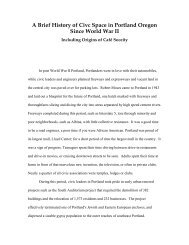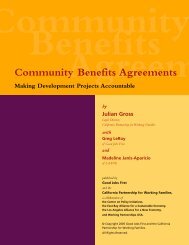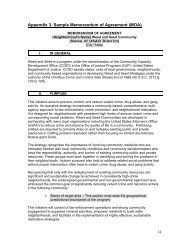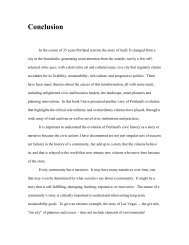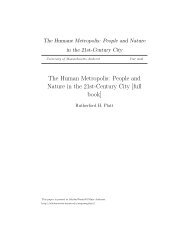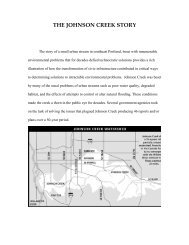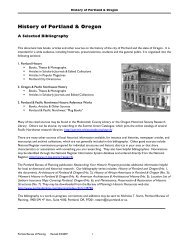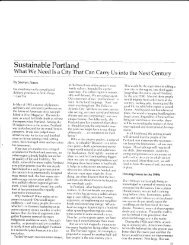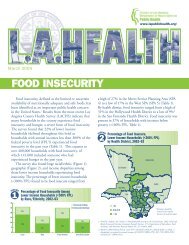Portland is known as one of the greenest cities in America, a ...
Portland is known as one of the greenest cities in America, a ...
Portland is known as one of the greenest cities in America, a ...
You also want an ePaper? Increase the reach of your titles
YUMPU automatically turns print PDFs into web optimized ePapers that Google loves.
<strong>Portland</strong> <strong>is</strong> <strong>known</strong> <strong>as</strong> <strong>one</strong> <strong>of</strong> <strong>the</strong> <strong>greenest</strong> <strong>cities</strong> <strong>in</strong> <strong>America</strong>, a reference to its<br />
commitment to greenspaces, susta<strong>in</strong>ability policies and programs, and smart<br />
growth plann<strong>in</strong>g regime. <strong>Portland</strong> h<strong>as</strong> been named <strong>the</strong> best bicycl<strong>in</strong>g city <strong>in</strong><br />
<strong>America</strong>, best walk<strong>in</strong>g city, and <strong>the</strong> city with <strong>the</strong> best susta<strong>in</strong>able policies and<br />
programs. There are more than 20,000 art<strong>is</strong>ts <strong>in</strong> <strong>the</strong> <strong>Portland</strong> area, 8th highest<br />
per capita <strong>in</strong> <strong>America</strong>n. It <strong>is</strong> considered <strong>one</strong> <strong>of</strong> <strong>the</strong> top three places for<br />
impendent film makers. There are more Peace Corps alumni than any o<strong>the</strong>r city <strong>in</strong><br />
<strong>America</strong>. The Center for Bus<strong>in</strong>ess Women's Research determ<strong>in</strong>ed <strong>Portland</strong> to have<br />
<strong>the</strong> most women owned bus<strong>in</strong>esses <strong>in</strong> an <strong>America</strong>n city.<br />
It h<strong>as</strong> also become <strong>one</strong> <strong>of</strong> <strong>the</strong> most favored dest<strong>in</strong>ations for <strong>the</strong> creative<br />
cl<strong>as</strong>s--young, well educated, entrepreneurial young people.. In 2007 <strong>the</strong>re were<br />
twice <strong>as</strong> many people <strong>in</strong> <strong>the</strong> 25-39 age group mov<strong>in</strong>g <strong>in</strong>to <strong>the</strong> city <strong>as</strong> leav<strong>in</strong>g. In<br />
all, 23,454 young adults moved <strong>in</strong> while 12,125 moved out. The fourth highest net<br />
migration <strong>in</strong> <strong>America</strong>. What lures <strong>the</strong>m to <strong>Portland</strong> are not job opportunities but<br />
elements <strong>of</strong> its greenness such <strong>as</strong> bike-friendl<strong>in</strong>ess, growth management policies,<br />
m<strong>as</strong>s transit, and social tolerance, <strong>in</strong>tellectual diversity and entrepreneurial<br />
opportunity. Also menti<strong>one</strong>d are local recreation opportunities, <strong>the</strong> music and<br />
art scenes, and o<strong>the</strong>r "consumption opportunities," for <strong>in</strong>stance, well-brewed<br />
beer. ╩<br />
While <strong>Portland</strong> w<strong>as</strong> awarded at le<strong>as</strong>t <strong>one</strong> livability award <strong>as</strong> early <strong>as</strong> 1976<br />
(Liu 1976), <strong>the</strong> story <strong>of</strong> <strong>Portland</strong> <strong>as</strong> a "success story" and <strong>as</strong> a draw for <strong>the</strong><br />
creative cl<strong>as</strong>s grew dramatically <strong>in</strong> <strong>the</strong> 1990s. Writ<strong>in</strong>g <strong>in</strong> The Atlantic Monthly,<br />
Philip Langdon (1992,p. 134) characterized <strong>Portland</strong> <strong>as</strong> "a paragon <strong>of</strong> healthy<br />
urban development at a time when most <strong>America</strong>n <strong>cities</strong> f<strong>in</strong>d <strong>the</strong>mselves mired <strong>in</strong><br />
seem<strong>in</strong>gly <strong>in</strong>tractable problems." Bus<strong>in</strong>ess Week (October 25, 1991, p. 136), <strong>in</strong> an<br />
evaluation <strong>of</strong> adm<strong>in</strong><strong>is</strong>trative effectiveness and efficiency, reported that<br />
"<strong>Portland</strong> <strong>is</strong> on <strong>the</strong> cutt<strong>in</strong>g edge <strong>of</strong> quality <strong>in</strong> municipal government." In<br />
Kipl<strong>in</strong>ger's Personal F<strong>in</strong>ance Magaz<strong>in</strong>e (October 25, 1991), Lynn and Mat<strong>the</strong>ws<br />
reported, "<strong>Portland</strong> <strong>is</strong> a West Co<strong>as</strong>t success story. High technology and<br />
manufactur<strong>in</strong>g keep expand<strong>in</strong>g. Yet <strong>of</strong>fice space, utilities, hous<strong>in</strong>g and taxes are<br />
lower than <strong>in</strong> California ... <strong>Portland</strong>'s squares, parks, walkable downtown and<br />
new light-rail transit system make <strong>the</strong> city a favorite" (pp. 42-43). Accord<strong>in</strong>g<br />
to <strong>the</strong> Econom<strong>is</strong>t, <strong>Portland</strong> <strong>is</strong> a plann<strong>in</strong>g paradigm that <strong>cities</strong> from New York to<br />
San Franc<strong>is</strong>co are try<strong>in</strong>g to emulate. It h<strong>as</strong> revived its h<strong>is</strong>toric d<strong>is</strong>trict,<br />
wrestled its Willamette River waterfront from <strong>the</strong> grip <strong>of</strong> ... "<strong>the</strong> demon auto,"<br />
built a successful m<strong>as</strong>s-transit system and nurtured some <strong>of</strong> <strong>the</strong> best<br />
architecture <strong>in</strong> North <strong>America</strong> ... urban delegations from dozens <strong>of</strong> <strong>America</strong>n<br />
<strong>cities</strong>--and also ... from <strong>the</strong> Brit<strong>is</strong>h <strong>cities</strong> <strong>of</strong> Manchester and Leeds--regularly<br />
troop through <strong>Portland</strong>, look<strong>in</strong>g for <strong>in</strong>spiration (September 1, 1990, pp. 24-25).<br />
The causes <strong>of</strong> <strong>Portland</strong>'s susta<strong>in</strong>ability achievements and attractiveness<br />
for <strong>the</strong> young creatives h<strong>as</strong> been <strong>as</strong>signed to enlightened leaders, above average<br />
and handsome planners, <strong>the</strong> landscape, and trickle down creativity from <strong>the</strong><br />
grow<strong>in</strong>g silicon forest <strong>in</strong>dustries <strong>in</strong> and around <strong>the</strong> city. I argue <strong>the</strong>re <strong>is</strong><br />
ano<strong>the</strong>r re<strong>as</strong>on, and that <strong>is</strong> <strong>Portland</strong>'s 40 year long <strong>in</strong>vestment <strong>in</strong> community<br />
governance. Citizens played a critical role <strong>in</strong> most all <strong>the</strong> elements that have<br />
made <strong>Portland</strong> a Mecca for <strong>the</strong> young creatives and its susta<strong>in</strong>ability<br />
achievements.<br />
Robert Putnam h<strong>as</strong> described <strong>Portland</strong> <strong>as</strong> a "civic puzzle." While <strong>the</strong> rest<br />
<strong>of</strong> <strong>the</strong> country suffered decl<strong>in</strong>es <strong>in</strong> civic <strong>in</strong>volvement over <strong>the</strong> l<strong>as</strong>t 40 years,<br />
<strong>Portland</strong> bucked <strong>the</strong> trend and achieved high levels <strong>of</strong> civic <strong>in</strong>volvement. Th<strong>is</strong><br />
book connects <strong>the</strong> dots. While civic and bus<strong>in</strong>ess leaders played critical roles<br />
<strong>in</strong> <strong>the</strong> green<strong>in</strong>g <strong>of</strong> <strong>Portland</strong>, it w<strong>as</strong> <strong>the</strong> gr<strong>as</strong>sroots that played <strong>the</strong> role <strong>of</strong> early<br />
implementer. Citizens, act<strong>in</strong>g al<strong>one</strong>, but more <strong>of</strong>ten through collective action,<br />
occupied civic space like pi<strong>one</strong>er<strong>in</strong>g plants <strong>in</strong> a clear-cut. When <strong>the</strong> baton w<strong>as</strong><br />
p<strong>as</strong>sed effectively, community leaders who understood <strong>the</strong>ir role <strong>as</strong> facilitators
<strong>of</strong> <strong>the</strong> w<strong>is</strong>dom <strong>of</strong> citizens, were able to implement policies that moved <strong>Portland</strong><br />
toward its livable and susta<strong>in</strong>able future.<br />
Over <strong>the</strong> l<strong>as</strong>t forty years <strong>the</strong> city h<strong>as</strong> created a civic story that h<strong>as</strong><br />
changed <strong>the</strong> vocabulary and grammar <strong>of</strong> civic life. Citizens <strong>in</strong> <strong>Portland</strong> expect to<br />
be <strong>in</strong>volved. <strong>America</strong>ns for <strong>the</strong> Arts, a national arts advocacy organization,<br />
recently noted that <strong>the</strong> city's <strong>in</strong>formal civic culture <strong>is</strong> <strong>one</strong> <strong>of</strong> its most<br />
important character<strong>is</strong>tics:<br />
People, <strong>in</strong>clud<strong>in</strong>g newcomers, feel <strong>the</strong>y can get <strong>in</strong>volved and have impact--<strong>in</strong><br />
politics, community development, plann<strong>in</strong>g, and <strong>in</strong> <strong>the</strong> cultural scene. Access and<br />
participation are e<strong>as</strong>y and welcomed. C<strong>of</strong>feehouses and cafes--<strong>the</strong> meet<strong>in</strong>g places<br />
<strong>of</strong> creatives--are ubiquitous. New organizations, coalitions, and movements--from<br />
political action committees to environmental coalitions, social justice<br />
organizations, and cultural entities--are constantly spr<strong>in</strong>g<strong>in</strong>g up [and] suggest<br />
several critical "<strong>in</strong>fr<strong>as</strong>tructural" attributes--<strong>in</strong> addition to its beautiful<br />
sett<strong>in</strong>g and moderate climate--that contribute to <strong>Portland</strong>'s attractiveness to<br />
creatives.<br />
If you <strong>as</strong>k a <strong>Portland</strong>er, or an outsider, about <strong>the</strong> orig<strong>in</strong>s <strong>of</strong> its<br />
reputation, if <strong>the</strong>y know it at all, <strong>the</strong>y will most likely identify a leader.<br />
They may know that <strong>in</strong> <strong>the</strong> 1970s Mayor Neil Goldschmidt w<strong>as</strong> responsible for<br />
<strong>in</strong>stigat<strong>in</strong>g <strong>in</strong>vestments <strong>in</strong> <strong>the</strong> light rail system MAX, or that Congressman Earl<br />
Blumenauer led <strong>the</strong> way to <strong>in</strong>vest <strong>in</strong> multi-modal transportation options. They<br />
are not likely to know about <strong>the</strong> ground work <strong>of</strong> <strong>the</strong> Sou<strong>the</strong><strong>as</strong>t <strong>Portland</strong> Legal<br />
Defense Fund <strong>in</strong> stopp<strong>in</strong>g <strong>the</strong> Mt. Hood Freeway that freed up m<strong>one</strong>y for <strong>the</strong><br />
development <strong>of</strong> MAX, or about a handful <strong>of</strong> students and a pr<strong>of</strong>essor at <strong>Portland</strong><br />
State University who led <strong>the</strong> charge <strong>in</strong> <strong>the</strong> early 1970s to have <strong>the</strong> bicycle taken<br />
seriously <strong>as</strong> a commut<strong>in</strong>g option. They will also <strong>as</strong>sume that susta<strong>in</strong>ability<br />
jumped onto <strong>the</strong> civic stage <strong>in</strong> <strong>the</strong> late 1980s after <strong>the</strong> Brundtland report, and<br />
publ<strong>is</strong>h<strong>in</strong>g <strong>of</strong> Our Common Future, and not know that gr<strong>as</strong>sroots organizations<br />
sewed <strong>the</strong> seeds <strong>of</strong> susta<strong>in</strong>ability <strong>in</strong> <strong>the</strong> Northwest twenty years before.<br />
Th<strong>is</strong> rev<strong>is</strong>ion<strong>is</strong>t h<strong>is</strong>torical perspective <strong>is</strong> important to correct <strong>as</strong> part <strong>of</strong><br />
a thorough h<strong>is</strong>tory <strong>of</strong> a community, and to give adequate dues to unsung heroes<br />
and groups. But, it <strong>is</strong> also important to correct th<strong>is</strong> view <strong>of</strong> h<strong>is</strong>tory because<br />
it teaches us about how change takes place <strong>in</strong> a community. Plac<strong>in</strong>g too much<br />
emph<strong>as</strong><strong>is</strong> on leader's role <strong>in</strong> a community implicitly teaches citizens that<br />
leaders lead and <strong>the</strong> people follow; not that people lead and Leaders follow. A<br />
typical h<strong>is</strong>tory <strong>of</strong> <strong>Portland</strong>, such <strong>as</strong> Jewell Lans<strong>in</strong>g's <strong>Portland</strong>: People, Power<br />
and Politics, while admirable, <strong>is</strong> only part <strong>of</strong> <strong>the</strong> story. Lans<strong>in</strong>g credits "<strong>the</strong><br />
people" at many times for critical public policies and civil projects,<br />
n<strong>one</strong><strong>the</strong>less, <strong>the</strong> h<strong>is</strong>tory <strong>is</strong> laid out <strong>as</strong> a series <strong>of</strong> regimes, and a hopscotch<br />
pattern <strong>of</strong> good and bad leaders. I argue that <strong>Portland</strong>'s h<strong>is</strong>tory, at le<strong>as</strong>t from<br />
<strong>the</strong> mid-1960s to <strong>the</strong> present, <strong>is</strong> better understood <strong>as</strong> a symbiotic relationship<br />
between civic leaders and <strong>the</strong> gr<strong>as</strong>sroots.<br />
In <strong>the</strong> early 1970s metropolitan <strong>Portland</strong> looked virtually identical to<br />
o<strong>the</strong>r U.S. metropolitan are<strong>as</strong> (<strong>in</strong>clud<strong>in</strong>g Seattle) <strong>in</strong> civic terms. Two decades<br />
later, <strong>Portland</strong> suburbs were roughly two to three times more civically active<br />
than comparable suburbs elsewhere, and <strong>Portland</strong> proper had become roughly three<br />
to four times more civically active than U.S. <strong>cities</strong> <strong>of</strong> comparable size. For<br />
example, <strong>in</strong> 1974, 21 percent <strong>of</strong> <strong>Portland</strong>ers attended at le<strong>as</strong>t <strong>one</strong> public meet<strong>in</strong>g<br />
on town or school affairs, compared to 22 percent for residents <strong>in</strong> comparable<br />
<strong>cities</strong>. By <strong>the</strong> early 1990s, <strong>the</strong> figure for <strong>the</strong> rest <strong>of</strong> <strong>the</strong> country w<strong>as</strong> 11<br />
percent, where<strong>as</strong> <strong>in</strong> <strong>Portland</strong> it had r<strong>is</strong>en to 30-35 percent (Putnam and Feldste<strong>in</strong><br />
(2002). Today <strong>the</strong>re are about 3000 civic organizations <strong>in</strong> <strong>Portland</strong>, 350<br />
environmental <strong>one</strong>s (compared to ten <strong>in</strong> <strong>the</strong> 1950s). One out <strong>of</strong> fifteen citizens<br />
<strong>in</strong> <strong>the</strong> metropolitan <strong>Portland</strong> area, population 2 million, are significantly<br />
<strong>in</strong>volved <strong>in</strong> public life.
<strong>Portland</strong>'s r<strong>is</strong>e <strong>in</strong> civic stature <strong>is</strong> extraord<strong>in</strong>ary by any standard. It <strong>is</strong><br />
even more <strong>as</strong>tound<strong>in</strong>g if you picture <strong>Portland</strong> <strong>in</strong> <strong>the</strong> 1950s, a strik<strong>in</strong>gly dull and<br />
derivative city, only a restaurant or two above a logg<strong>in</strong>g town. Civic <strong>Portland</strong><br />
circa 1950s <strong>is</strong> summed up by a photograph <strong>of</strong> <strong>Portland</strong>'s Redevelopment Board, a<br />
predecessor to <strong>the</strong> <strong>Portland</strong> Development Comm<strong>is</strong>sion, <strong>Portland</strong>'s urban renewal<br />
agency: all white men, sitt<strong>in</strong>g around a rectangular table, <strong>in</strong> suits and ties,<br />
<strong>as</strong>htrays l<strong>in</strong>ed up like today's water bottles. It w<strong>as</strong> a Ple<strong>as</strong>antville k<strong>in</strong>d <strong>of</strong><br />
place, if you were male, white, Chr<strong>is</strong>tian, and patriotic.<br />
Civic life <strong>in</strong> <strong>the</strong> 1950s <strong>in</strong> <strong>Portland</strong> w<strong>as</strong> dom<strong>in</strong>ated by traditional civic<br />
organizations: fraternal and benevolent organizations, women╒s clubs, voluntary<br />
and charitable organizations, ethnic cultural groups, and direct social service<br />
organizations. The predom<strong>in</strong>ant civic activities <strong>of</strong> <strong>the</strong>se traditional civic<br />
organizations were acts <strong>of</strong> charity and community service. Traditional civic<br />
organizations had m<strong>in</strong>imal impact on political participation and dec<strong>is</strong>ion mak<strong>in</strong>g<br />
<strong>in</strong> <strong>the</strong> community. The formal mechan<strong>is</strong>ms for citizens <strong>in</strong>volvement <strong>in</strong> political<br />
dec<strong>is</strong>ion mak<strong>in</strong>g were limited to elite and pr<strong>of</strong>essionally driven city comm<strong>is</strong>sions<br />
and boards, traditional political party organizations, and formal public hear<strong>in</strong>g<br />
processes.<br />
But, someth<strong>in</strong>g happened <strong>in</strong> <strong>Portland</strong> <strong>in</strong> <strong>the</strong> late 1960s to <strong>the</strong> mid-1980s,<br />
what I call <strong>the</strong> civic reconstruction period. Traditional civic organizations<br />
lost <strong>the</strong>ir position <strong>as</strong> primary vehicles for community <strong>in</strong>volvement. The rights<br />
<strong>of</strong> citizens to participate <strong>in</strong> public life were codified, and <strong>the</strong> repertories <strong>of</strong><br />
actions and opportunities for <strong>in</strong>volvement were expanded. It w<strong>as</strong> both an<br />
excit<strong>in</strong>g and d<strong>is</strong>turb<strong>in</strong>g period for <strong>Portland</strong>ers, <strong>as</strong> close to revolution <strong>as</strong> mild<br />
<strong>Portland</strong> had accommodated. The chang<strong>in</strong>g <strong>of</strong> <strong>the</strong> guard dur<strong>in</strong>g th<strong>is</strong> period w<strong>as</strong> a<br />
generational transaction <strong>as</strong> baby boomers entered civic life <strong>in</strong> <strong>Portland</strong>,<br />
d<strong>is</strong>plac<strong>in</strong>g civic <strong>in</strong>stitutions and practices. Ra<strong>the</strong>r <strong>the</strong>n jo<strong>in</strong><strong>in</strong>g establ<strong>is</strong>hed<br />
<strong>in</strong>stitutions, members <strong>of</strong> <strong>the</strong> baby boomer generation <strong>in</strong> <strong>Portland</strong> created new<br />
<strong>one</strong>s. Less than 20% <strong>of</strong> all civic organizations <strong>in</strong> <strong>Portland</strong> <strong>in</strong> ex<strong>is</strong>tence <strong>in</strong> <strong>the</strong><br />
1950s, ex<strong>is</strong>t today.<br />
Dur<strong>in</strong>g <strong>the</strong> popul<strong>is</strong>t plural<strong>is</strong>t period, mid-1980s to <strong>the</strong> mid-1990s, new<br />
<strong>in</strong>stitutions and practices took hold. Civic life <strong>in</strong>corporated <strong>the</strong> broadest cross<br />
section <strong>of</strong> citizens <strong>in</strong> public policy deliberation, and <strong>the</strong> practice <strong>of</strong> <strong>in</strong>volv<strong>in</strong>g<br />
citizens <strong>in</strong> all manner <strong>of</strong> public policy debates and formation w<strong>as</strong> taken for<br />
granted. Dur<strong>in</strong>g th<strong>is</strong> time <strong>Portland</strong> fully embraced a popul<strong>is</strong>t or participatory<br />
view <strong>of</strong> democracy.<br />
By <strong>the</strong> mid-1990s, while many civic <strong>in</strong>stitutions and practices endured and<br />
prospered, <strong>the</strong>re w<strong>as</strong> a recognition <strong>of</strong> some <strong>of</strong> <strong>the</strong> "excesses <strong>of</strong> democracy." The<br />
City faced more <strong>in</strong>stances <strong>of</strong> policy gridlock, <strong>in</strong> part brought on by <strong>the</strong> r<strong>is</strong>e <strong>of</strong><br />
privit<strong>is</strong>t, anti-government, and NIMBY (Not In My BackYard) challeng<strong>in</strong>g<br />
organizations. But <strong>as</strong> Friedland and Siranni have argued, civic challenges like<br />
<strong>the</strong>se have <strong>of</strong>ten been met, <strong>as</strong> <strong>the</strong>y were <strong>in</strong> <strong>Portland</strong>, through civic <strong>in</strong>novations.<br />
For example, when faced with too many well-articulated public or citizen<br />
<strong>in</strong>terest groups, activ<strong>is</strong>ts <strong>in</strong> <strong>Portland</strong> created <strong>the</strong> Coalition for a Livable<br />
Future, a federation <strong>of</strong> 60 (now 100) NGOs represent<strong>in</strong>g environmental, social<br />
justice, food security, and affordable hous<strong>in</strong>g <strong>in</strong>terests. Ra<strong>the</strong>r than fight<strong>in</strong>g<br />
among <strong>the</strong>mselves, CLF helped forge policies that represented multiple <strong>in</strong>terests<br />
under <strong>the</strong> common rubric <strong>of</strong> creat<strong>in</strong>g a socially just and environmentally<br />
susta<strong>in</strong>able region.<br />
Even after a deep exploration <strong>of</strong> how <strong>Portland</strong> created a community<br />
governance model <strong>of</strong> <strong>the</strong> pol<strong>is</strong>, <strong>the</strong>re may be questions about why <strong>in</strong> <strong>Portland</strong>.<br />
W<strong>as</strong> it someth<strong>in</strong>g about <strong>the</strong> landscape or people? It may go back to that<br />
h<strong>is</strong>torical anecdote repeated <strong>in</strong> a variety <strong>of</strong> ways that pi<strong>one</strong>ers on <strong>the</strong> Oregon<br />
Trail, reached a juncture. There w<strong>as</strong> a sign at <strong>the</strong> juncture. It w<strong>as</strong> written,<br />
"th<strong>is</strong> way to Oregon," po<strong>in</strong>t<strong>in</strong>g north, while <strong>the</strong> sign po<strong>in</strong>t<strong>in</strong>g south to
California, merely had a picture <strong>of</strong> gold. Those that could read <strong>the</strong> sign went<br />
to Oregon, while those that wanted to get rich went south. Abbott h<strong>as</strong> also<br />
del<strong>in</strong>eated some <strong>of</strong> <strong>the</strong> character <strong>of</strong> <strong>Portland</strong> and Oregon politics that might<br />
expla<strong>in</strong> th<strong>is</strong> civic puzzle, <strong>in</strong>clud<strong>in</strong>g: weak political parties, nonpart<strong>is</strong>an city<br />
and county elections, ethnic groups with limited political salience, and weak<br />
labor unions. He also speaks to some <strong>of</strong> <strong>the</strong> weaknesses <strong>of</strong> <strong>the</strong> political milieu,<br />
<strong>in</strong>clud<strong>in</strong>g that Oregon <strong>is</strong> always a place where strong <strong>in</strong>dividual<strong>is</strong>m tempers and<br />
challenges strong communitarians, that <strong>the</strong> civic movement <strong>is</strong> fragile, always<br />
under challenge not from mach<strong>in</strong>e politics but from <strong>the</strong> values <strong>of</strong> privat<strong>is</strong>m, and<br />
l<strong>as</strong>tly that with all its virtues, <strong>the</strong> <strong>Portland</strong> style tends to muffle radically<br />
d<strong>is</strong>sent<strong>in</strong>g voices who are unwill<strong>in</strong>g to work on <strong>the</strong> ╥team.╙ There <strong>is</strong> an<br />
<strong>in</strong>ability to hear new ide<strong>as</strong> until <strong>the</strong>y fit <strong>the</strong> mold. Some <strong>of</strong> <strong>the</strong>se place<br />
specific character<strong>is</strong>tics may temper <strong>the</strong> universality <strong>of</strong> <strong>the</strong> <strong>Portland</strong> story, but<br />
<strong>the</strong> underly<strong>in</strong>g prem<strong>is</strong>e <strong>is</strong> hopefully still valid, that a healthy civic life <strong>is</strong> an<br />
essential element <strong>of</strong> creat<strong>in</strong>g a socially and environmentally susta<strong>in</strong>able<br />
community.



